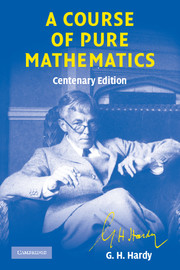Book contents
- Frontmatter
- FOREWORD
- PREFACE
- Contents
- CHAPTER I REAL VARIABLES
- CHAPTER II FUNCTIONS OF REAL VARIABLES
- CHAPTER III COMPLEX NUMBERS
- CHAPTER IV LIMITS OF FUNCTIONS OF A POSITIVE INTEGRAL VARIABLE
- CHAPTER V LIMITS OF FUNCTIONS OF A CONTINUOUS VARIABLE. CONTINUOUS AND DISCONTINUOUS FUNCTIONS
- CHAPTER VI DERIVATIVES AND INTEGRALS
- CHAPTER VII ADDITIONAL THEOREMS IN THE DIFFERENTIAL AND INTEGRAL CALCULUS
- CHAPTER VIII THE CONVERGENCE OF INFINITE SERIES AND INFINITE INTEGRALS
- CHAPTER IX THE LOGARITHMIC, EXPONENTIAL, AND CIRCULAR FUNCTIONS OF A REAL VARIABLE
- CHAPTER X THE GENERAL THEORY OF THE LOGARITHMIC, EXPONENTIAL, AND CIRCULAR FUNCTIONS
- APPENDIX I The inequalities of Hölder and Minkowski
- APPENDIX II The proof that every equation has a root
- APPENDIX III A note on double limit problems
- APPENDIX IV The infinite in analysis and geometry
- INDEX
APPENDIX IV - The infinite in analysis and geometry
Published online by Cambridge University Press: 05 June 2012
- Frontmatter
- FOREWORD
- PREFACE
- Contents
- CHAPTER I REAL VARIABLES
- CHAPTER II FUNCTIONS OF REAL VARIABLES
- CHAPTER III COMPLEX NUMBERS
- CHAPTER IV LIMITS OF FUNCTIONS OF A POSITIVE INTEGRAL VARIABLE
- CHAPTER V LIMITS OF FUNCTIONS OF A CONTINUOUS VARIABLE. CONTINUOUS AND DISCONTINUOUS FUNCTIONS
- CHAPTER VI DERIVATIVES AND INTEGRALS
- CHAPTER VII ADDITIONAL THEOREMS IN THE DIFFERENTIAL AND INTEGRAL CALCULUS
- CHAPTER VIII THE CONVERGENCE OF INFINITE SERIES AND INFINITE INTEGRALS
- CHAPTER IX THE LOGARITHMIC, EXPONENTIAL, AND CIRCULAR FUNCTIONS OF A REAL VARIABLE
- CHAPTER X THE GENERAL THEORY OF THE LOGARITHMIC, EXPONENTIAL, AND CIRCULAR FUNCTIONS
- APPENDIX I The inequalities of Hölder and Minkowski
- APPENDIX II The proof that every equation has a root
- APPENDIX III A note on double limit problems
- APPENDIX IV The infinite in analysis and geometry
- INDEX
Summary
The infinite in analysis and geometry
Some, though not all, systems of analytical geometry contain ‘infinite’ elements, the line at infinity, the circular points at infinity, and so on. The object of this brief note is to point out that these concepts are in no way dependent upon the analytical doctrine of limits.
In what may be called ‘common Cartesian geometry’ a point is a pair of real numbers (x, y). A line is the class of points which satisfy a linear relation ax + by + c = 0, in which a and b are not both zero. There are no infinite elements, and two lines may have no point in common.
In a system of real homogeneous geometry a point is a class of triads of real numbers (x, y, z), not all zero, triads being classed together when their constituents are proportional. A line is a class of points which satisfy a linear relation ax + by + cz = 0, where a, b, c are not all zero. In some systems one point or line is on exactly the same footing as another. In others certain ‘special’ points and lines are regarded as peculiarly distinguished, and it is on the relations of other elements to these special elements that emphasis is laid. Thus, in what may be called ‘real homogeneous Cartesian geometry’, those points are special for which z = 0, and there is one special line, viz. the line z = 0. This special line is called ‘the line at infinity’.
- Type
- Chapter
- Information
- A Course of Pure Mathematics , pp. 502 - 504Publisher: Cambridge University PressPrint publication year: 2008



